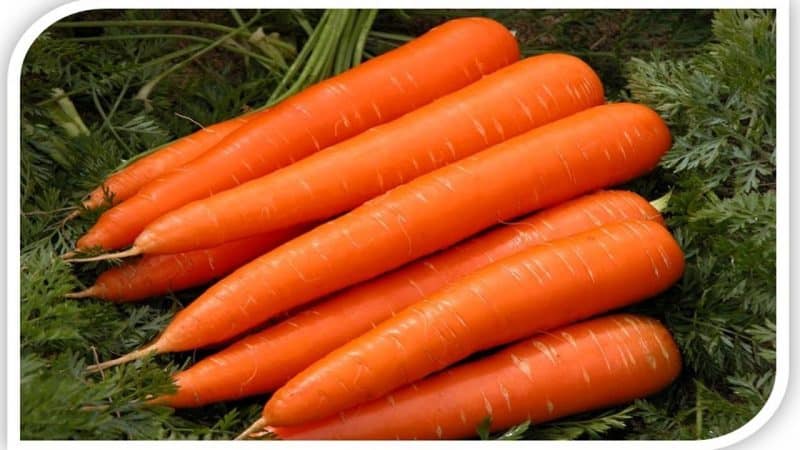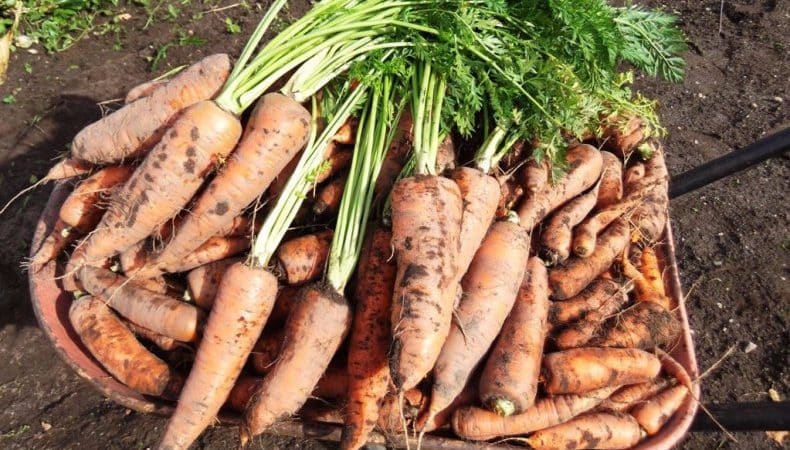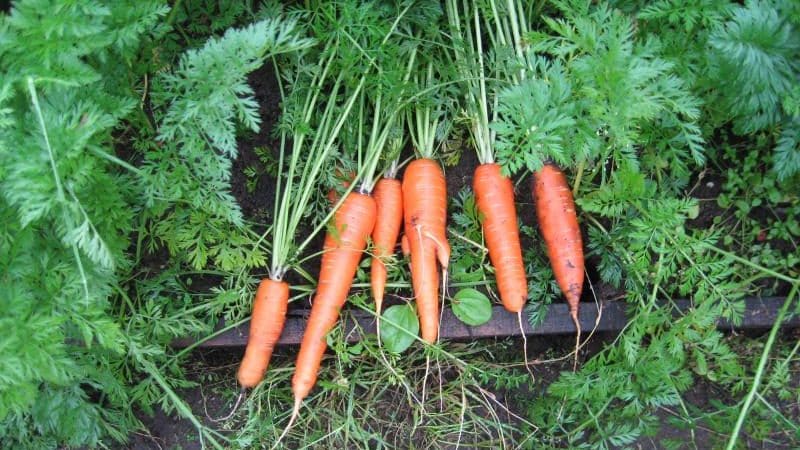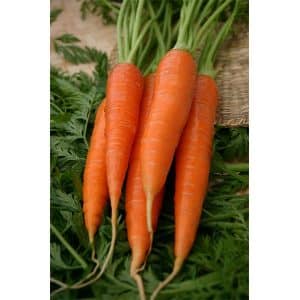Frost-resistant carrot variety Queen of Autumn
Queen of Autumn carrots are among the most popular late-ripening varieties among farmers. The culture is in wide demand due to its qualities: unpretentiousness in cultivation, resistance to diseases, and versatility in use. The variety is not afraid of slight frosts and produces a rich harvest in many regions of the country.
Characteristics and description of the Queen of Autumn carrot variety
Queen of Autumn is a late-ripening carrot variety with a long ripening period - 110-135 days. The variety is cold-resistant and easily tolerates temperatures down to –4°C. The rosette of the variety is powerful, of medium height. Characterized by long root crops reaching 30 cm.
Root vegetables contain small amounts of carotene. Productivity is high.

Origin and development
Queen of Autumn belongs to the Flakke-carotene variety (in Russian terminology - Valeria). Included in the State Register of Breeding Achievements of the Russian Federation in 2005. Originators: NPF Russian Seeds CJSC, Intersemya LLC, Euroseeds LLC. Regions of admission to cultivation: Central Black Earth, Volgo-Vyatka, Far Eastern.
Chemical composition, trace elements and vitamins, beneficial properties
100 g of raw carrots contain: dry matter - 10.2-16.3%, sugars - 6.4-10.9%, carotene - 10.2-16.7 mg, energy value - 24.2 kcal.
Nutritional value is determined by a rich set of vitamins, macro- and microelements.
Macronutrient content:
- potassium – 204 mg;
- calcium – 24.1 mg;
- phosphorus – 46 mg;
- magnesium – 35.3 mg;
- sodium – 17.2 mg;
- sulfur – 4.7 mg.
Microelements content:
- iron – 0.79 mg;
- zinc – 0.32 mg;
- aluminum – 0.24 mg;
- manganese – 0.21 mg;
- boron – 0.2 mg;
- copper – 0.7 mg;
- fluorine – 0.49 mg.
Vitamin content:
- A – 0.93 mg;
- B1 – 0.07 mg;
- B2 – 0.05 mg;
- B9 – 0.12 mg;
- C – 0.44 mg;
- RR – 1.2 mg;
- E – 0.7 mg.
Carrots have a beneficial effect on the human body: normalizes intestinal microflora, improves gastrointestinal function, vision, and prevents the formation of stones in the gall bladder and kidneys.
Features of application
The use of root vegetables is universal. The variety is used for fresh eating, preparing freshly squeezed juices, baby vegetable purees, first courses, and side dishes. Used for stewing canning, frost. Carrots good stored during the winter, suitable for fresh use in winter.
Ripening period
The variety is late ripening. The ripening period is 110-135 days.
Productivity
The productivity of the Queen of Autumn is 3.2-8.5 kg/m2.
The maximum indicators for industrial cultivation were 668 c/ha.
Disease resistance
The variety has stable immunity to many crop diseases, in particular, plants are rarely affected by powdery mildew and brown spot.
Characteristics, description of appearance, taste

The Queen of Autumn is characterized by a dense, spreading rosette. The leaves are light green, dissected. Root vegetables have the shape of an oblong cone with a pointed tip. The length of the fruit is 23-30 cm, weight 160-240 g. The color of carrots is red-orange. Pulp juicy, sweet, crispy.
Reference. The Queen of Autumn fruits usually have a smooth surface, but sometimes lumpy specimens are found.
For which regions is it suitable, climate requirements?
The variety is recommended for cultivation in the Volga-Vyatka, Central Black Earth, and Far Eastern regions of the country. Carrots are cold-resistant varieties and grow well in the northern regions.
Main advantages and disadvantages
The variety has many advantages:
- high productivity;
- long shelf life;
- crack resistance;
- persistent immunity to diseases;
- color resistance.
Disadvantages of the variety:
- difficulty in extracting long roots during harvest;
- Root crops have different sizes; for storage, sorting by size is required.
What is the difference from other varieties
Unlike many varieties, the Queen of Autumn is not susceptible to bolting.
The fruits do not crack when the soil moisture is high.
Features of planting and growing
To grow the crop, choose an area well lit by the sun, not obscured by trees. The beds should not be located in low areas, as rainwater will accumulate there - this will lead to the formation of rot.
Reference. High ridges are used to grow the variety.
Preparing for landing
Before planting, seeds are prepared. First, undamaged specimens are selected and soaked in water for 1-1.5 hours. During this time, empty seeds will float to the surface and are thrown away. Good seeds are taken out of the container and disinfected in a solution of potassium permanganate or Fitosporin-M for an hour.
After this, the seeds are germinated in a damp cloth in a warm, bright place for a week. Before planting, the seeds are treated with a growth stimulator "Epin" or "Zircon".
Soil requirements
The culture grows well on light, permeable, fertile soils. In heavy clay soils, root crops will become deformed and grow poorly.The addition of peat and sand in the fall will improve fruiting rates. The variety responds well to sandy, loamy soils with neutral acidity.
In the fall, the site is dug up deeply, removing stones from the soil and breaking up large lumps of soil. Complex fertilizers, ash, and humus are added to the soil.
In the spring, the soil is loosened and organic matter is added again.
Predecessors
The best predecessors for culture – tomatoes, cabbage, cucumbers, onions, potatoes, cereals. The variety is not recommended to be planted after dill, parsley, parsnips, since they and carrots have identical diseases and pests.
Dates, scheme and rules of planting
Queen of Autumn carrots are planted in late April or early May. In cold areas, planting is carried out at the end of May. The main condition is that the soil must warm up to +6...+8°C.
For this variety, high beds are used, on the flat top of which grooves 2-2.5 cm deep are made. The distance between the beds is 25-30 cm. The grooves are shed with warm water. The seeds are laid out at a distance of 2-3 cm and covered with a loose layer of soil, pressing lightly.
Features of cultivation
Carrots tolerate temperature drops down to –4°C well and can be grown until mid-autumn.
Young seedlings also withstand low temperatures, but during prolonged cold spells the growth of the crop slows down. The optimal temperature for growth is +18…+25°C.
When growing crops, one should not allow the formation of a soil crust, which prevents air access to the roots.
Nuances of care
Under favorable conditions, carrot shoots appear 12-14 days after sowing. To prevent the beds from becoming covered with weeds during this time, the soil is covered with a transparent film. This reduces moisture evaporation and accelerates the emergence of seedlings.
During the first thinning, weak shoots are removed carefully so as not to damage the young roots of the shoots remaining in the garden bed. The holes from the removed shoots are covered with earth, and the soil is watered to restore the development of the remaining shoots.
Watering mode
The emerging seedlings are watered every 3 days in the morning with warm water. It is advisable to water by sprinkling to prevent erosion of high beds. As soon as the seedlings become stronger, watering is reduced to once a week. In order for root crops to grow evenly, the soil must be constantly slightly moist. As the root crops grow, the volume of liquid added is increased.
Attention! Watering should not be superficial; the beds should be moistened to a depth of 25-30 cm.
Watering is stopped 3-4 weeks before harvest. This will preserve the sweetness and juiciness of the vegetable.
Thinning and weed control
As soon as the seedlings reach 5-6 cm, the first thinning is carried out: weak, undeveloped specimens are removed.
The second thinning is carried out during the formation of root crops. Leave 3 cm between sprouts.
The following thinnings are carried out as the plantings thicken, removing weaker plants and leaving a distance of 6 cm for free growth of the remaining ones.
Simultaneously with thinning, weeds that inhibit crop growth are removed.
Top dressing
The first time the crop is fed after the first thinning, nitrogen substances are used. The beds are watered with urea: 10 g of the product per 10 liters of water.
Fertilize the second time after 3 weeks, during the formation of the root crop. At this time, potassium and phosphorus fertilizers are applied: 20 superphosphate, 15 g of potassium sulfate per 10 liters of water.
Important! You cannot use fresh manure; it will add bitterness to the root crop and distort the shape of the vegetables.
The third feeding is carried out 20 days after the second. Prepare the composition: 2 g of potassium permanganate, 3 g of boric acid are dissolved in 10 liters of water.
Mineral fertilizing alternates with organic matter.
Attention! Nitrogen fertilizers are not used after the root crop has formed.
Disease and pest control
If preventive measures were not taken during the growing season, the crop may be affected by some diseases.
Fomoz
Dry rot begins on the tops in the form of gray-brown spots; areas of rot form on the root crops. For prevention, seeds are heated to +50°C before sowing, and potassium fertilizers are added to the soil. At the first manifestations of the disease, copper-containing drugs are used.
Alternaria blight
Black rot. It starts with blackening of leaves and stems, then moves to root vegetables. At the first signs, the plants are sprayed with the preparation “Rovral”: 1 g of fungicide is diluted in 1 liter of water. The same composition is used to water the beds with 0.5 liters for each plant.
Bacteriosis
It begins on the lower leaves as yellowish areas that darken with increasing size. The stems become covered with dark brown spots, and wet, depressed lesions form on the roots. For prevention and treatment illnesses plants are sprayed with fungicide "HOM".
Important! Chemical protection products are used only at the early stage of vegetable growth.
Pests of crops:
- Carrot fly and its larvae. The presence of a fly is indicated by the bronze tint of the leaves. An effective method of control is pollination with wood ash. In advanced cases, plants are treated with insecticides “Aktellik” and “Decis”.
- Carrot moth eats the above-ground parts of the crop. To combat it, spray with an infusion of tomato tops with the addition of liquid soap.If there are a large number of pests, use the drug “Entobacterin” (30 g of product per 10 liters of water).
Harvest and storage

The Autumn Queen harvest begins in mid-October. It is important not to make a mistake with the harvesting time, since unripe vegetables will begin to rot, and overripe ones will have a shorter shelf life.
How and when to collect
The degree of maturity of root crops is judged by the yellowing of the lower leaves of the tops.
The harvest is harvested in dry weather. When grown in light, loose soil, the roots are easily removed by hand. If removal is difficult, use a pitchfork. Vegetables are shaken off the ground, the tops are cut or rolled.
The carrots are immediately sorted: the damaged ones are put aside for processing, the good ones are laid out in a dry room to dry for a week. Then the root crops are placed in containers with sand and sawdust and transferred to the vegetable storage.
Storage features and keeping quality of the variety
A microclimate is created in the storage facility with an air temperature of +2...+4°C, humidity 85-90%, and constant air ventilation. In such conditions, the keeping quality of the variety reaches 98%.
What difficulties may there be when growing
Make sure that the soil is moistened to a depth of 25-30 cm, since shallow watering of the beds leads to the formation of numerous small roots on root crops.
Frequent heavy watering deteriorates the taste of carrots. The quality of vegetables becomes similar to forage varieties.
Advice from experienced gardeners

To make it easier to sow small seeds, gardeners advise mixing them with dry sand and pouring them into the furrows.
Experienced farmers stick seeds at the required intervals on paper tape and embed it into the soil.
Experienced gardeners recommend cutting the tops 0.5 cm below the growth point. In this case, the greens will not absorb juices from the root crop.
Reviews of the Queen of Autumn carrot variety
Growing the Queen of Autumn carrot variety is not difficult, many summer residents say so.
Svetlana, Tula: “I’m planting the Autumn Queen for the second season. Growing is easy. The taste is good. The harvest does not spoil until spring.”
Igor, Tomsk: “I’ve been growing this variety for several years. Despite the different sizes of root crops, I really like the variety. Easy to grow and store in winter. Carrots do not wither or spoil during storage. The grandchildren love the sweet, freshly squeezed juice.”
Olga, Pskov: “I really like the Queen of Autumn variety. There were no problems with growing. The fruits are sweet, crispy, and not bitter. I store it in the cellar in boxes with sand. They retain elasticity until spring.”
Conclusion
Queen of Autumn is a popular variety of late-ripening carrots. It is a cold-resistant variety that can withstand temperatures down to –4°C. This allows for early sowing and late harvesting. The variety attracts with its taste, resistance to disease and ease of care.